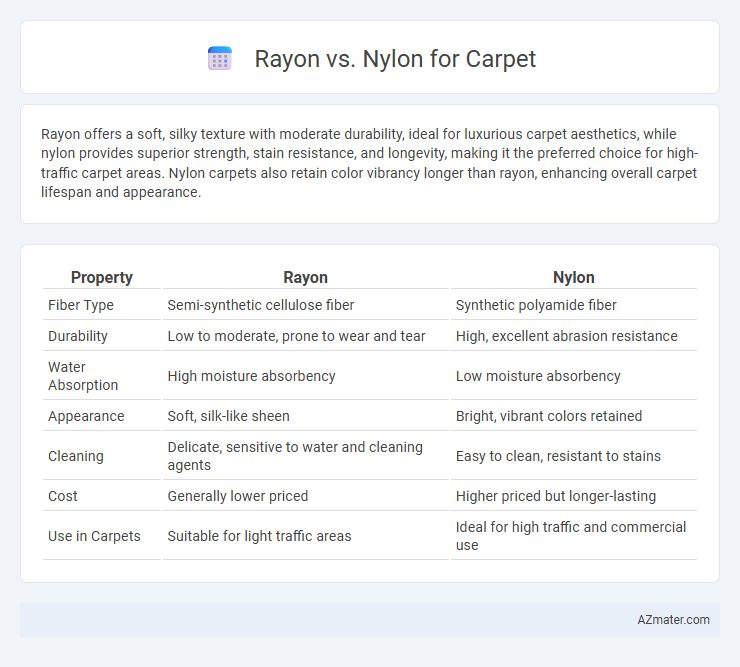Rayon offers a soft, silky texture with moderate durability, ideal for luxurious carpet aesthetics, while nylon provides superior strength, stain resistance, and longevity, making it the preferred choice for high-traffic carpet areas. Nylon carpets also retain color vibrancy longer than rayon, enhancing overall carpet lifespan and appearance.
Table of Comparison
| Property | Rayon | Nylon |
|---|---|---|
| Fiber Type | Semi-synthetic cellulose fiber | Synthetic polyamide fiber |
| Durability | Low to moderate, prone to wear and tear | High, excellent abrasion resistance |
| Water Absorption | High moisture absorbency | Low moisture absorbency |
| Appearance | Soft, silk-like sheen | Bright, vibrant colors retained |
| Cleaning | Delicate, sensitive to water and cleaning agents | Easy to clean, resistant to stains |
| Cost | Generally lower priced | Higher priced but longer-lasting |
| Use in Carpets | Suitable for light traffic areas | Ideal for high traffic and commercial use |
Introduction to Rayon and Nylon Carpets
Rayon and nylon are two popular synthetic fibers used in carpet manufacturing, each offering unique benefits. Rayon carpets are known for their soft texture and natural sheen, resembling silk, but they tend to have lower durability and moisture resistance compared to nylon. Nylon carpets excel in resilience, stain resistance, and longevity, making them ideal for high-traffic areas and demanding environments.
Material Composition: Rayon vs Nylon
Rayon carpets are made from regenerated cellulose fibers derived primarily from wood pulp, offering a soft, silk-like texture but lower durability and moisture resistance. Nylon carpets consist of synthetic polyamide polymers, providing exceptional resilience, abrasion resistance, and superior stain protection compared to rayon. The material composition of nylon makes it more suitable for high-traffic areas, while rayon fibers are more prone to crushing and damage under heavy use.
Durability Comparison: Which Carpet Lasts Longer?
Nylon carpets demonstrate superior durability compared to rayon, with higher resistance to abrasion, crushing, and wear, making them ideal for high-traffic areas. Rayon, while more affordable and offering a soft, luxurious feel, tends to be less resilient and more susceptible to moisture damage and fading over time. Choosing nylon ensures a longer-lasting carpet that maintains appearance and performance under frequent use.
Stain Resistance and Maintenance
Nylon carpets exhibit superior stain resistance due to their engineered synthetic fibers that repel spills and resist water-based stains, making maintenance easier in high-traffic areas. Rayon carpets, while softer and more affordable, are prone to absorb stains quickly and require more frequent and careful cleaning to avoid permanent damage. Choosing nylon ensures longer-lasting carpet appearance with minimal upkeep, especially in environments prone to dirt and spills.
Comfort and Texture: Feel Underfoot
Rayon carpets offer a silky, soft texture that mimics natural fibers, delivering a luxurious and smooth feel underfoot. Nylon carpets provide excellent resilience and bounce-back, maintaining comfort and softness even in high-traffic areas. While rayon feels plush and delicate, nylon combines softness with durability, making it ideal for both comfort and long-term use.
Aesthetic Appeal and Color Retention
Rayon carpets offer a luxurious, silk-like sheen that enhances aesthetic appeal but tend to fade more quickly under sunlight or heavy use compared to nylon. Nylon carpets provide vibrant color retention and resist fading better, making them ideal for high-traffic areas where maintaining consistent color is essential. The dye affinity of nylon fibers ensures long-lasting hues, while rayon's natural cellulose structure results in less durable color stability.
Environmental Impact and Sustainability
Rayon carpets, derived from regenerated cellulose fibers, have a lower environmental impact compared to nylon due to their biodegradable nature and use of renewable resources like wood pulp. Nylon carpets, made from synthetic polymers, are less sustainable because of their petroleum-based origins and longer decomposition time, contributing to microplastic pollution. Choosing rayon over nylon can reduce overall carbon footprint and support more eco-friendly carpet production practices.
Cost Analysis: Rayon vs Nylon Carpets
Rayon carpets typically cost less than nylon carpets due to their lower manufacturing expenses and limited durability. Nylon carpets, though more expensive upfront, offer superior resilience and longer lifespans, reducing replacement frequency and long-term maintenance costs. Evaluating total cost of ownership, nylon provides better value for high-traffic areas, while rayon suits budget-conscious projects with lower durability demands.
Best Applications for Each Carpet Type
Rayon carpets excel in indoor areas with low to moderate foot traffic due to their soft texture and vibrant color retention, making them ideal for bedrooms and living rooms. Nylon carpets offer superior durability and stain resistance, perfectly suited for high-traffic zones such as hallways, offices, and commercial spaces. Selecting between rayon and nylon depends on balancing aesthetic appeal with wear resistance based on the carpet's location and usage intensity.
Final Verdict: Choosing the Right Carpet Material
Rayon carpets offer a soft, luxurious feel but lack durability and stain resistance compared to nylon, making them less suitable for high-traffic areas. Nylon stands out for its exceptional resilience, easy maintenance, and resistance to wear, making it the preferred choice for both residential and commercial carpets. For long-lasting performance and practicality, nylon remains the superior carpet material.

Infographic: Rayon vs Nylon for Carpet
 azmater.com
azmater.com